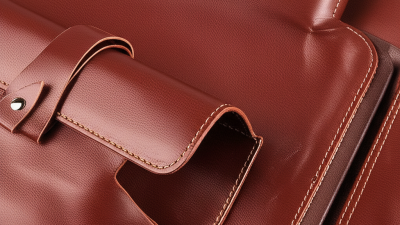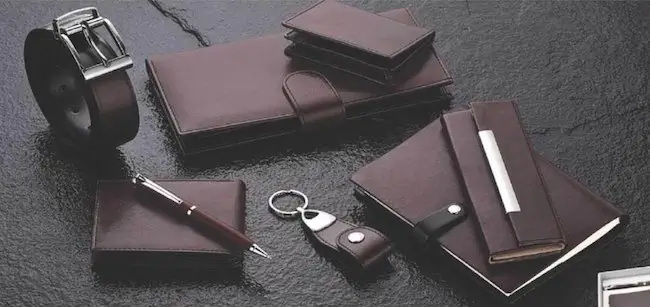Common Issues Faced When Choosing Best Leather Accessories
In today's global market, leather accessories stand out not only for their aesthetic appeal but also for their durability and functionality. As reported by the Statista Research Department, the global leather goods market is expected to reach approximately $430 billion by 2025, showcasing a robust growth trajectory driven by rising consumer demand for high-quality leather products. However, the journey to choose the best leather accessories can be fraught with common issues. Consumers frequently face challenges such as discerning genuine leather from synthetic alternatives, understanding the implications of various tanning processes, and identifying reputable brands that align with sustainability practices. With numerous options available, navigating this landscape requires informed decision-making to ensure that buyers invest in lasting quality and style. Recognizing these challenges empowers consumers to make educated choices in a rapidly evolving marketplace.

Understanding Different Types of Leather Materials for Accessories
When it comes to selecting the best leather accessories, understanding the various types of leather materials is crucial. The leather goods industry is anticipated to grow significantly, with the market projected to rise from an estimated value of USD 493.58 billion in 2025 to USD 904.41 billion by 2035, achieving a compound annual growth rate (CAGR) of 5.6%. This growth signifies a rising interest in not only traditional leather but also alternative materials like faux leather and innovative options such as cactus leather, which caters to the growing demand for sustainable fashion.
For those navigating the leather accessories market, here are a few tips to help with your selection process. First, familiarize yourself with the different leather grades: full-grain leather is the highest quality, while corrected-grain leather offers a more budget-friendly alternative. Second, consider the application—items like bags and wallets require durability, so opt for thicker leather types. Lastly, keep an eye out for the eco-friendly alternatives that are gaining traction, as the global faux leather market is projected to grow from $37.59 billion in 2025 to $57.94 billion by 2032, at a CAGR of 6.38%. This trend is indicative of consumer preferences shifting toward versatile and sustainable options.
Common Leather Types for Accessories
This chart shows the different types of leather used in accessories and their common issues faced by consumers when selecting the best option.
Key Considerations When Selecting Leather Accessories for Durability
When selecting leather accessories, durability stands out as a primary concern. One key consideration is the quality of the leather itself. Top-grain and full-grain leather are often regarded as the most durable options, as they maintain the natural characteristics of the hide and develop a beautiful patina over time. In contrast, bonded or corrected leather might appear more affordable, but they often lack the resilience needed to withstand daily wear and tear. Therefore, understanding the types of leather available is crucial to making an informed choice.
Another important factor to consider is the craftsmanship involved in creating the leather accessory. Hand-stitched items generally indicate superior quality, as they are less likely to come apart compared to mass-produced pieces with machine stitching. Additionally, details such as reinforced edges and high-quality hardware can enhance the longevity of the accessory. By focusing on these aspects, consumers can ensure they are investing in leather accessories that not only look stylish but also stand the test of time.
The Importance of Craftsmanship in Leather Accessories Quality
When selecting the best leather accessories, understanding the importance of craftsmanship is crucial. High-quality leather products are not merely defined by the type of leather used, but significantly by the skill and attention to detail of the artisans who create them. Craftsmanship elevates leather accessories from mere functional items to works of art. It is the intricate stitching, the precise cuts, and the meticulous finishing that enhance the durability and aesthetic appeal of the product.
Artisans who prioritize craftsmanship often incorporate traditional techniques that have been passed down through generations. This dedication to quality ensures that each piece tells a story, reflecting both the heritage of the craft and the individuality of the owner. Additionally, well-crafted leather accessories adapt beautifully to wear over time, developing a unique patina that adds character. Investing in craftsmanship means choosing products that not only look good but also stand the test of time, making them a sustainable choice for consumers who value quality and longevity.
Identifying Authentic vs. Faux Leather: What to Look For
When choosing leather accessories, distinguishing between authentic leather and faux leather can be quite challenging. Authentic leather not only has a unique texture and smell but also boasts durability and longevity that faux options often lack. To ensure you are making the right choice, it's important to examine the material closely. Real leather will have slight imperfections and a natural grain pattern, while faux leather tends to appear more uniform and sometimes overly shiny.
Tips to identify authentic leather include conducting a simple burn test — real leather will singe and emit a burnt smell, while faux leather will melt and emit a plastic scent. Additionally, check the edges of the material; genuine leather will have natural, unfinished edges, whereas faux leather typically has smooth, sealed edges.
Another key indicator is the price. Authentic leather products tend to be more expensive due to the quality of materials and craftsmanship involved. If a deal seems too good to be true, it probably is. Taking the time to research the brand and read customer reviews can also guide you toward finding genuine leather accessories that are worth your investment.
Budgeting Wisely: Balancing Cost and Quality in Leather Choices
When it comes to selecting the best leather accessories, budgeting wisely is essential. High-quality leather products often come with a hefty price tag, reflecting the craftsmanship and materials used. However, it's important to strike a balance between cost and quality. Investing in an accessory that may seem expensive initially can save money in the long run, as durable leather goods can last for years with proper care. Therefore, setting a realistic budget that allows for quality pieces rather than opting for cheaper, low-quality alternatives can be a smart financial decision.
To make informed choices, consumers should consider what they truly need and how often they will use the leather accessory. For instance, a well-made leather wallet might be pricier, but if it endures daily usage over several years, the cost per use becomes minimal. Additionally, exploring various brands and understanding the differences in leather types can help in making a more informed purchase. By prioritizing both budget and quality, shoppers can find leather accessories that not only meet their aesthetic preferences but also withstand the test of time.
Common Issues Faced When Choosing Best Leather Accessories - Budgeting Wisely: Balancing Cost and Quality in Leather Choices
| Leather Type | Average Cost ($) | Durability (Years) | Maintenance Level | Common Issues |
|---|---|---|---|---|
| Full Grain Leather | 250 | 10-20 | Low | Requires conditioning, can be expensive |
| Top Grain Leather | 200 | 5-15 | Medium | Less breathable than full grain, can scratch easily |
| Genuine Leather | 100 | 3-10 | High | May crack or fade, lower durability |
| Bonded Leather | 50 | 1-3 | High | Peels easily, low quality |
| Suede Leather | 150 | 2-5 | Medium | Stains easily, sensitive to moisture |

